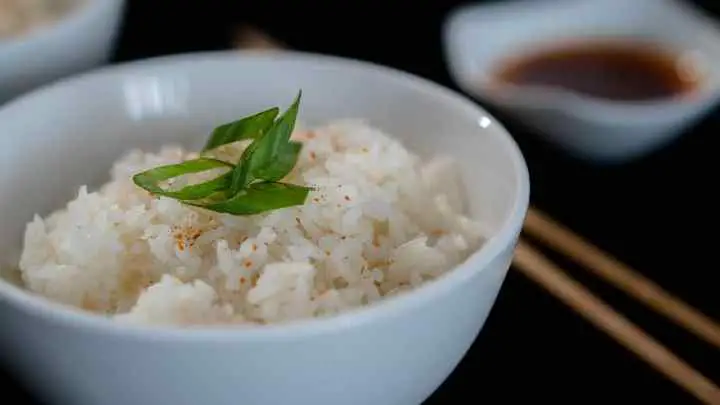When you think of rice, what comes to mind, what probably comes to mind is white rice because it is one of the most commonly consumed varieties of rice. Well, technically, you are not wrong.
But you must already know that countless other varieties of rice are available in the market. There is brown rice, jasmine rice, basmati rice, red rice, Calrose rice and so much more.
However, from a nutritional standpoint, each type of rice has its nutrient to offer depending on how you choose to prepare and consume it.
In this article, I will be discussing Calrose rice vs Jasmine rice extensively, the difference, their benefits, where they originate from, which dishes you can use them for, and then which of these two varieties is better for your health.
What is Calrose Rice?
Calrose rice is a medium grain. It becomes slightly soft and sticky after cooking. It is a versatile grain that can be used in various dishes.
Origin of Calrose Rice
This medium grain originates from California. The name “Calrose” comes from “cal” as a nod to the state of California, where the grain is grown. And “rose,” a continuation of the naming tradition that includes “blue rose,” a medium grain previously developed in Louisiana.
This Calrose rice is developed at the rice experiment station run by the California Rice Research Foundation. It was released in 1948 and quickly became one of the state’s most popular staples.
What Can You Eat With Calrose Rice?
While there are several dishes to enjoy Calrose rice with, a few stands out. Once cooked, you can enjoy it with flavor-based side dishes or sauces, such as soup, curries, and stews. You can also use Calrose rice to make sushi as it tends to be sticky.
What are the Benefits of Eating Calrose Rice
1. Low Calories
Calrose rice is considerably low on calories, making it okay to eat without worrying about your waistline increasing uncontrollably.
2. Great Source of Carbohydrates
Carbohydrate is a source of energy; it is like fuel source your body and brain need to perform at optimal capacity, and Calrose rice has a very high amount of carbohydrates.
3. Low Arsenic
Calrose rice has very low arsenic. Arsenic is a chemical compound sprayed on crops to keep insects from spoiling them, and this chemical may increase the cancerous cells present in your body if consumed in excess.
What is Jasmine Rice?
Jasmine rice is a long grain also known as “aromatic rice” It mimics the fragrance of brown basmati rice. It is a moist, soft, and fluffy texture when cooked. Although it is not as sticky as other rice varieties, it has a slightly sweeter flavor than jasmine rice.
Origin of Jasmine Rice
This long-grain originates from Thailand. It was founded in the 1950s, and it became a staple diet in the entire Asia region. It is also one of the country’s biggest export to this very day. Jasmine rice got its name not because of its aroma but from its color, which is similar to that of the jasmine flower.
SEE: If Jasmine Rice is Good for Diabetics
What Can You Eat With Jasmine Rice?
You can enjoy jasmine rice with side dishes like coconut and sweet raisins, and you can also make Pilaf and one-pan shrimp using this rice.
What are the Benefits of Eating Jasmine Rice
1. Boost Energy
Jasmine rice is also rich in carbohydrates which your body and brain need to perform well, and it also provides the energy you need to go about your daily activities.
2. Good Source of Fiber
The fiber from jasmine rice is very useful as they help to regulate the blood sugar level of your body. This fiber will help reduce the risk of any heart disease.
3. Easy Digestion
Jasmine rice helps ease metabolism, reducing the risk of constipation, bloating, and other digestion-related problems.
4. Rich in Iron
Jasmine rice is a natural source of Iron, a mineral that aids growth and development in the body. Iron produces a substance called hemoglobin which helps carry oxygen from the lungs to other body parts.
5. Boost Immunity
The folate nutrient obtained from jasmine rice improves the ability of the body’s cells to divide. This folate also affects the cells of your immune system.
Calrose Rice vs Jasmine Rice, Which is Better?
Although Calrose rice is high in carbohydrates, it lacks major nutrients such as dietary fiber, vitamin A, vitamin C, calcium, and iron and contains very small amounts of protein. It also contains sugar which is detrimental to your health.
Jasmine rice, on the other hand, has loads of vitamins, fiber, and carbs and is very helpful for weight loss. It is easy to digest and has a low glycemic index, making it a good choice for people with diabetes. Jasmine rice is even recommended for pregnant women as it contains folic acid, which helps in averting neural tube defects.
Taking these points into consideration, Jasmine rice is a better option than Calrose rice.
SEE: How to Lose Weight With Rice
FAQs
Is jasmine rice gluten-free?
Yes, jasmine rice is gluten-free. Unprocessed rice is usually gluten-free.
What is the amount of carbs in Calrose rice?
Calrose rice contains about 80 grams of carbs.
What is the amount of carbs in Jasmine rice?
Jasmine rice contains about 40 grams of carbs.
Which rice is better for diabetes, Calrose or Jasmine?
Jasmine rice is better for diabetes as it has a lower glycemic index.
Conclusion: Calrose Rice vs Jasmine Rice Which is Healthier?
While Calrose rice is healthy, Jasmine rice is a healthier option. But always remember to eat in moderate quantities as excess intake may affect your diet.
Even though Calrose rice is rich in carbs and low in cholesterol, it has so many side effects and lacks so many nutrients that your body needs. Most people eat Calrose rice alongside nutrient-rich dishes to improve its nutrients.
Some even stir-fry it alongside healthy veggies. While this is okay, it is still a better option to go for Jasmine rice’s long grain.
I hope you enjoyed this article. If you did, then you should also see the side effects of eating undercooked rice.
Thank you for reading this article.






